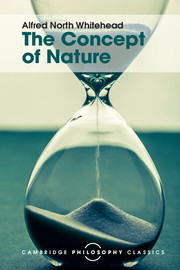9 - The ultimate physical concepts
Published online by Cambridge University Press: 05 November 2015
Summary
The second chapter of this book lays down the first principle to be guarded in framing our physical concept. We must avoid vicious bifurcation Nature is nothing else than the deliverance of sense-awareness. We have no principles whatever to tell us what could stimulate mind towards sense-awareness. Our sole task is to exhibit in one system the characters and inter-relations of all that is observed. Our attitude towards nature is purely ‘behaviouristic,’ so far as concerns the formulation of physical concepts.
Our knowledge of nature is an experience of activity (or passage). The things previously observed are active entities, the ‘events.’ They are chunks in the life of nature. These events have to each other relations which in our knowledge differentiate themselves into space-relations and time-relations. But this differentiation between space and time, though inherent in nature, is comparatively superficial; and space and time are each partial expressions of one fundamental relation between events which is neither spatial nor temporal. This relation I call ‘extension.’ The relation of ‘extending over’ is the relation of ‘including,’ either in a spatial or in a temporal sense, or in both. But the mere ‘inclusion’ is more fundamental than either alternative and does not require any spatio-temporal differentiation. In respect to extension two events are mutually related so that either (i) one includes the other, or (ii) one overlaps the other without complete inclusion, or (iii) they are entirely separate. But great care is required in the definition of spatial and temporal elements from this basis in order to avoid tacit limitations really depending on undefined relations and properties.
Such fallacies can be avoided by taking account of two elements in our experience, namely, (i) our observational ‘present,’ and (ii) our ‘percipient event.’
- Type
- Chapter
- Information
- The Concept of NatureTarner Lectures, pp. 118 - 127Publisher: Cambridge University PressPrint publication year: 2015

